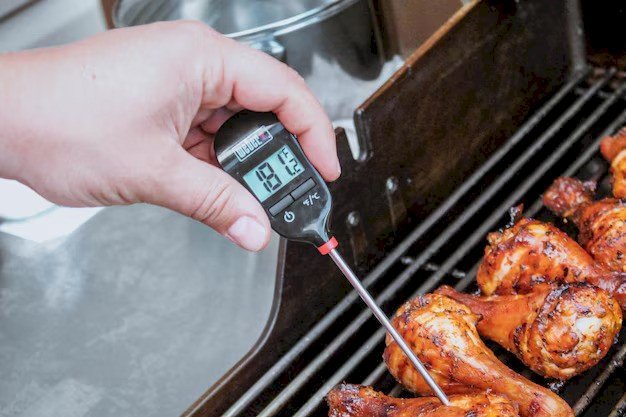Why a Wireless Meat Thermometer Is the Secret to Perfect Cooking in 2025
Discover why a wireless meat thermometer is essential in 2025. Learn how it ensures food safety, precision, and consistency, plus the top models worth buying this year.

Cooking has always been a blend of creativity and science. While seasoning and flair bring artistry, accuracy ensures food safety and repeatable results. In 2025, no tool better represents this balance than the wireless meat thermometer. Once a novelty for barbecue enthusiasts, it is now a must-have for everyday cooks, holiday hosts, and pitmasters.
From weeknight meals to competition briskets, wireless thermometers provide the confidence that food will be perfectly cooked, every single time.
The Smart Cooking Revolution

Image source: pinterest.com
The smart cooking trend is transforming kitchens worldwide. With devices that sync to apps and smart displays, consumers now expect both precision and convenience. Wireless thermometers meet this demand by freeing cooks from hovering over food and guessing doneness. Instead, real-time data is delivered to smartphones, allowing more freedom in the kitchen or backyard.
Market forecasts indicate that connected cooking appliances will grow at 12–15% annually through 2030, and wireless thermometers are at the center of this boom. Surveys suggest that nearly nine out of ten frequent grill users will own one by the end of 2025. This is no longer a trend—it’s a standard.
How Wireless Meat Thermometers Work

Image source: pinterest.com
A probe is placed into the thickest part of the meat, where tiny sensors measure both internal and ambient temperatures. Advanced probes in 2025 use six to eight sensors to detect the coldest point—the true thermal center—ensuring accuracy. Data is transmitted wirelessly through Bluetooth, Wi-Fi, or Sub-1 GHz RF radios to an app or hub.
The connected app displays real-time graphs, alerts, and even predicted cooking and resting times. This means no more lifting lids, opening ovens, or second-guessing doneness.
Why They Matter: Precision, Safety, and Freedom

Image source: pinterest.com
The biggest advantage is precision. Cooking based on color or timing is risky. Pink pork may look undercooked yet be safe at 145°F with a rest, while chicken is unsafe until 165°F is reached. The USDA confirms these minimums for food safety:
-
Poultry (whole or ground): 165°F (73.9°C)
-
Whole cuts of beef, pork, lamb, veal: 145°F (62.8°C) with 3-minute rest
-
Ground meats: 160°F (71.1°C)
-
Fish: 145°F (62.8°C)
Wireless thermometers make it simple to hit these targets.
Freedom is the second advantage. Instead of babysitting a smoker or oven, you can entertain guests or multitask while the app notifies you when food is done. For long barbecue sessions, some thermometers offer reliable range up to 1500 ft, meaning you can step away or even nap while your cook is monitored.
Finally, consistency becomes standard. That perfect steak or juicy roast turkey is no longer luck—it becomes repeatable every time.
Innovations Defining 2025

Image source: pinterest.com
The latest models are packed with features unimaginable just a few years ago:
-
Multi-sensor accuracy: Typhur Sync uses six sensors per probe; Combustion has eight, ensuring detection of the coldest point.
-
Extreme heat tolerance: MEATER Pro withstands up to 1000°F ambient—perfect for direct-flame grilling.
-
Stable connectivity: ThermoWorks RFX and FireBoard Pulse use Sub-1 GHz RF for strong signals through walls and smokers.
-
Predictive cooking algorithms: Apps estimate finish and rest times, updating in real time.
-
Durability upgrades: Probes now feature dishwasher-safe, waterproof builds with ratings from IPX8 to IP69K.
Market Growth and Adoption

Image source: pinterest.com
The wireless thermometer market is expanding rapidly. In 2024, it was valued at $384 million, and by 2033 it is projected to surpass $1.1 billion at a CAGR of 12.8%. Another forecast places the 2025 valuation at $500 million, climbing to $1.5 billion by 2033.
Growth drivers include increased awareness of foodborne illnesses, the popularity of backyard cooking, and the rise of cooking influencers who highlight these devices on social media.
Everyday Scenarios

Image source: pinterest.com
Consider a few common situations:
-
A parent roasting chicken can help with homework, trusting their phone to notify them at 165°F.
-
A holiday host no longer guesses whether the turkey is done; the app predicts doneness and rest time, helping coordinate side dishes.
-
A pitmaster smoking brisket overnight relies on long-range RF to monitor while sleeping, waking only if needed.
-
A data enthusiast logs every cook with Combustion’s predictive probe, analyzing graphs to refine techniques.
Choosing the Right Wireless Thermometer

Image source: pinterest.com
When selecting a model, key factors include:
-
Accuracy: Look for ±1°F precision.
-
Connectivity: Bluetooth is fine for short range, but Wi-Fi or Sub-1 GHz is better for long smokes.
-
Heat tolerance: Grillers need probes rated for extreme ambient heat.
-
Battery life: 24–50+ hours per charge with quick-charge features is ideal.
-
Number of probes: Singles work for steaks, while dual or quad probes suit larger BBQs.
-
App features: Predictive algorithms, presets, and alerts enhance usability.
If you want the best wireless meat thermometer in 2025, select one that balances accuracy, durability, and connectivity for your cooking style. For reader convenience, we’ve included links to trusted retailers—some of which may return a small commission that helps support our editorial work. Recommendations, however, are based solely on performance and usefulness.
Leading Models in 2025

Image source: pinterest.com
-
MEATER 2 Plus (Pro): Fully wireless, 1000°F ambient tolerance, excellent predictive app.
-
Typhur Sync (Gold/Quad): Six-sensor probes, Sub-1 GHz stability, over 50 hours of runtime.
-
ThermoWorks RFX: Professional-grade RF, ±0.9°F accuracy, separate ambient probe for true pit temps.
-
FireBoard Pulse: Combines Sub-1 GHz with cloud integration, favored by smoking enthusiasts.
-
Combustion Predictive Thermometer: Eight sensors, dishwasher-safe, designed for data-driven cooks.
Using Wireless Thermometers Effectively

Image source: pinterest.com
For best results, insert the probe into the thickest part of the meat, away from bone or fat. Trust the thermometer rather than appearance; pork can stay pink at safe temperatures, and smoked meats retain rosy rings. Expect stalls during long cooks around 150–170°F, caused by evaporative cooling. Predictive apps will help you ride out or work around these stalls.
Always account for carryover cooking. Many apps advise pulling meat a few degrees before target temperature, knowing it will rise during the rest. Finally, clean probes after each use and calibrate periodically with ice and boiling water tests to maintain accuracy.
Final Thoughts
In 2025, wireless meat thermometers have evolved from gadgets into indispensable cooking tools. They bring precision, safety, and convenience to the kitchen and grill. With multi-sensor probes, durable builds, advanced connectivity, and predictive intelligence, they empower home chefs and pitmasters alike to cook with confidence.
Whether you are preparing a weeknight dinner, hosting a holiday feast, or managing a long smoke, the right thermometer ensures your food is perfectly cooked every single time. As smart kitchens continue to grow, this small but mighty tool remains one of the most impactful upgrades you can make.
FAQs
-
Are wireless probes accurate enough for professionals? Yes. Multi-sensor designs are highly accurate, and competitive teams use them.
-
Can they handle direct flames? Certain models, such as the MEATER Pro, are rated for 1000°F ambient temperatures.
-
Do predictive apps really work? Yes, algorithms calculate cook time and rest periods based on temperature curves.
-
What is the realistic range? Bluetooth covers up to 150 ft; Sub-1 GHz extends to 1500 ft; Wi-Fi/cloud allows global access.
-
What about leftovers? Always refrigerate within two hours, or within one hour if the temperature exceeds 90°F outdoors.

















